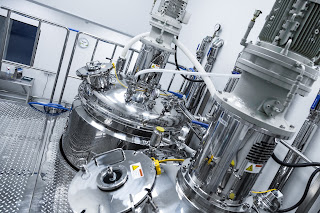 |
Process refractometer with sanitary adapter
for food and pharmaceutical. (Electron Machine) |
There are many industrial applications for
process refractometers; particularly useful in the food and pharmaceutical industries, where there is a need for
solids content measurement. Process refractometers are used to optimize production processes, ensure consistency and purity, and in managing quality control. Process refractometers and inline process refractometers, are types of refractometers designed for the continuous measurement of a fluid flowing through a pipe or inside a tank. They provide analysis to quickly, dependably, and to accurately identify a sample to determine its concentration and purity levels. By measuring the refractive index and temperature of flowing liquids, refractometers can then apply a mathematical function to determine the precise concentration of dissolved solids.
In commercial food applications such as jam or jelly production or the processing of soft drinks or wine, refractometers are used to measure degrees Brix. Bix is a graduated scale, used on a hydrometer, that indicates the weight of sugar per volume of solution at a given temperature. The Brix scale relates refractive index to sugar concentration, and is a method of maintaining consistency. For example, process refractometers are used for the concentration process of fruit juices. The concentration process is normally achieved by removing water through evaporation, and by measuring Brix, the evaporation process can be controlled and related to the desired juice concentration.
Process refractometers are also used in pharmaceutical processing where there is the need to monitor and control concentration levels during supersaturation, a critical process in crystallization. Crystallization is a critical element in the purification of solids in pharmaceutical production. The process refractometer guarantees precise monitoring and a high degree of measurement accuracy and reliability, towards the production of a pure product.
 A bioprocess control system update helped a leading manufacturer of USDA-licensed biologicals improve batch consistency. The pharmaceutical manufacturer had an 800 liter, 30+ year-old stainless steel, steam-in-place (SIP) reactor that was mechanically sound but in desperate need of a new controller. They needed to replace the production capability and required flexible controls for the varying products their customers produced. Of foremost concern was the cost to replace the idle system. ILS Automation came to their rescue.
A bioprocess control system update helped a leading manufacturer of USDA-licensed biologicals improve batch consistency. The pharmaceutical manufacturer had an 800 liter, 30+ year-old stainless steel, steam-in-place (SIP) reactor that was mechanically sound but in desperate need of a new controller. They needed to replace the production capability and required flexible controls for the varying products their customers produced. Of foremost concern was the cost to replace the idle system. ILS Automation came to their rescue.




